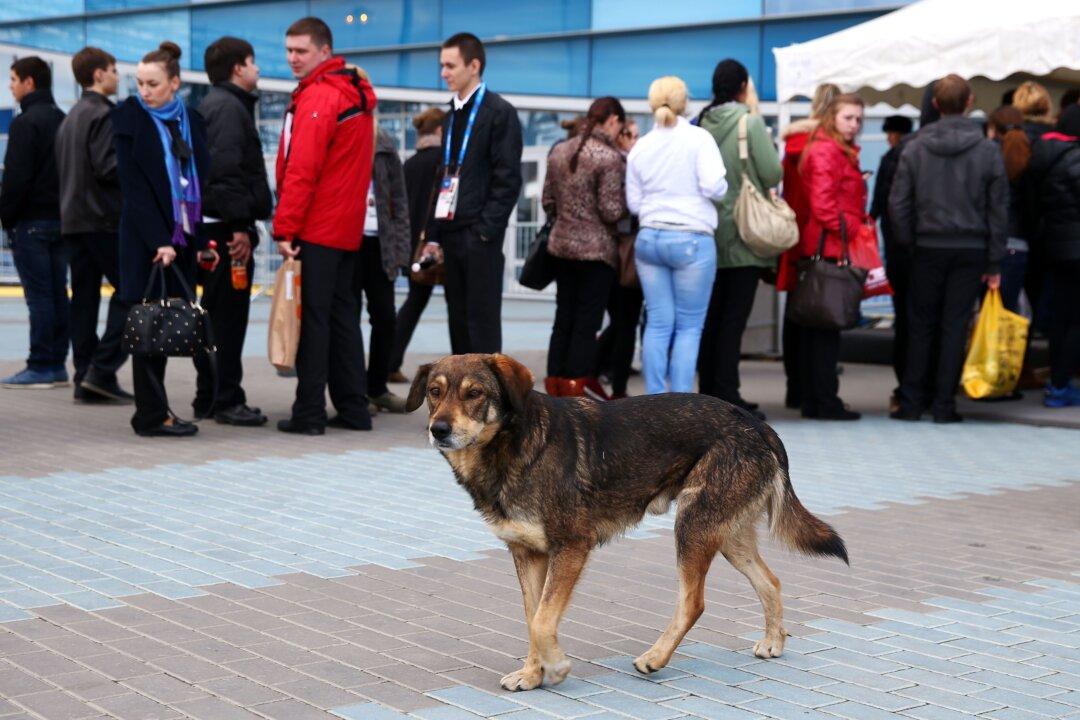Hundreds of Sochi’s stray dogs narrowly escaped death decreed by Russian authorities last week after a local billionaire stepped in to save them from a pre-Olympics “cull.” Animal rights groups are now seeking new homes for the dogs, putting the spotlight on the practice of international pet adoption.
In recent years, Canada has been gaining a reputation as an increasingly popular haven for stray dogs from countries like India, China, Greece, Russia, and Mexico.
Neither the Canada Border Services Agency nor Statistics Canada keep tabs on how many stray dogs are being brought into the country, but with hundreds of adoption groups operating here, it is estimated that thousands—possibly tens of thousands—of strays are imported each year.
Canada’s increasing numbers of non-profit animal rescue groups are willing to bring in dogs from virtually any country in the world. There’s no shortage of need—the World Health Organization estimates there are at least 200 million stray dogs roaming cities worldwide.
Calgary-based dog rescue foundation Pawsitive Match Inc. brings in about 800-900 dogs per year from Mexico, the U.S., and occasionally Thailand, and also finds homes for stray and surrendered dogs within Canada.
Canada’s well-established spay and neuter program and animal rights values, as well as shortages of certain breeds, make it an ideal home for strays, says Pawsitive Match president Tracy Babiak.
“Canada is probably really close to the top for spay and neuter. As far as dog rescue, there’s European countries that are probably as good, but we’re definitely really far ahead of the U.S. and places like that,” she says.
Pawsitive Match was born when a group of Canadian tourists observed the dire situation for thousands of stray dogs in Mexico. They rescued 50 dogs by bringing them to Canada in 2007, which sparked a broader mission to rescue dogs facing “life-threatening circumstances.”
The non-profit has a no-kill policy and places animals in volunteer foster homes until they are adopted into their “forever” families.
The group also works to promote responsible pet ownership and holds spaying and neutering clinics in Mexico as well as on First Nations reserves in Canada. They expanded their adoption services south of the border when organizers realized some American cities also had severe problems with strays.
“We found out that the situation in L.A. is almost as bad, if not as bad as Mexico. So we started bringing dogs in from L.A. as well,” says Babiak.
“They’re just not an educated society as far as proper pet ownership goes. There’s no spay and neuter. There’s people breeding their dogs in the backyard. There’s just no education there for the proper care of dogs.”
In one case last year, at least 1,000 dogs were brought in from Las Vegas through Foreclosed Upon Pets International, a program that sought to re-house pets after America’s foreclosure crisis of 2008 left ousted homeowners scrambling and thousands of animals to fend for themselves.
Canada’s Strays Forgotten?
Canada’s relatively stable economy and strong animal welfare values have put it on the map as a haven for stray dogs; only 14 percent of dogs taken in by various SPCAs and humane societies each year are put to death, compared to 60 percent in the U. S.
But not everyone agrees that international adoption is a good idea. Some humane societies and animal rights activists have expressed concern that the practice displaces local dogs in need of rescuing from Canada’s overcrowded shelters.
“The issue of overpopulation in Canada is huge. It is much larger than most people realize because it is hidden,” says the website for the Vancouver Island Dogs Rescue Society on a page titled “Why we don’t import.”
The society, which specializes in rescuing dogs from the Northern Territories, estimates that two “import” dogs are rescued for every one within Canada.
“There are so many rescues focusing on dogs across borders while dogs already here in Canada are being forgotten and overlooked over and over again,” says the website. “We feel strongly that Canadian dogs should be the top priority.”
Babiak, who has fostered at least 50 dogs in the last few years, says in her experience there isn’t a conflict because the breeds Pawsitive Match brings in from other countries, such as miniature poodles and chihuahuas, are often unavailable in Canada.
“It’s more of a supply and demand thing,” she says, adding that Pawsitive Match often rescues dogs from the Canadian North as well.
“If we’ve got dogs coming in from the Northwest Territories that are shepherds and huskies, we’re not going to bring those type of dogs in from abroad. It doesn’t make sense, because they’re available here.”
Organizations like Pawsitive Match often save the dogs that are hard to place and would otherwise be euthanized, says Babiak, noting that the organization has done a lot to raise awareness about the need for adoption versus purchasing dogs from a pet store.
“We’ve been able to replace that puppy mill mentality-buying a dog from a pet store—with rescuing a dog. We’ve achieved a lot over the last five years or so,” she says.
“That’s really the market that we’ve tried to replace, rather than the pound or the humane society. They do their thing and we do ours.”




